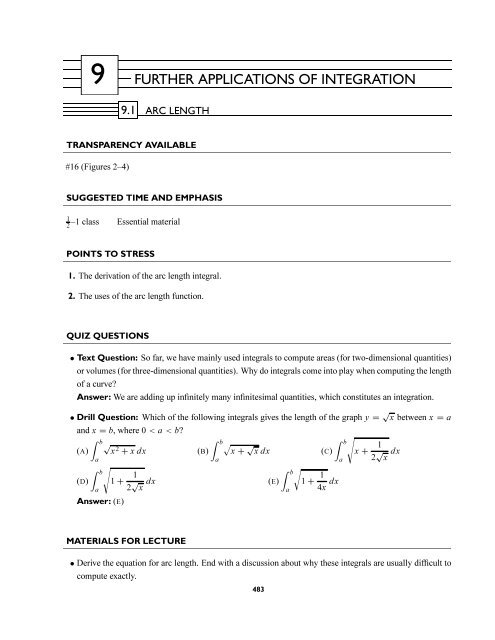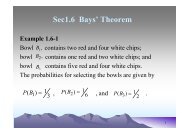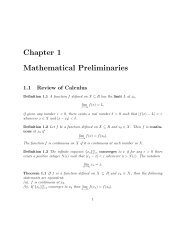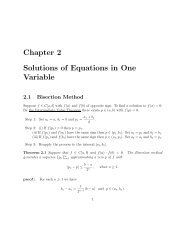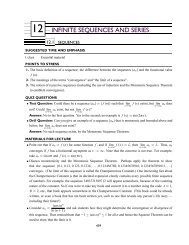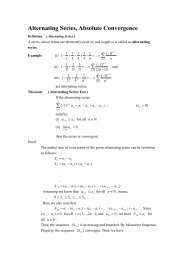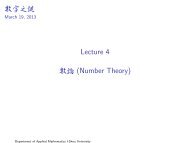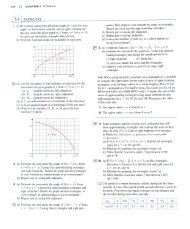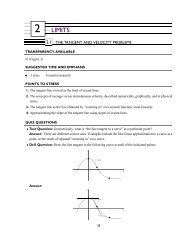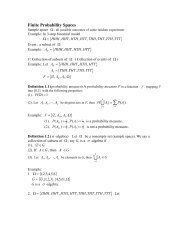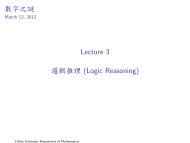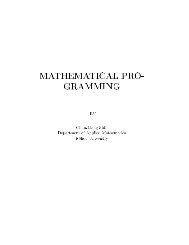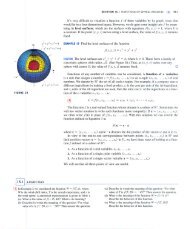9 FURTHER APPLICATIONS OF INTEGRATION
9 FURTHER APPLICATIONS OF INTEGRATION
9 FURTHER APPLICATIONS OF INTEGRATION
Create successful ePaper yourself
Turn your PDF publications into a flip-book with our unique Google optimized e-Paper software.
9 <strong>FURTHER</strong> <strong>APPLICATIONS</strong> <strong>OF</strong> <strong>INTEGRATION</strong><br />
9.1 ARC LENGTH<br />
TRANSPARENCY AVAILABLE<br />
#16 (Figures 2–4)<br />
SUGGESTED TIME AND EMPHASIS<br />
1<br />
2<br />
–1 class Essential material<br />
POINTS TO STRESS<br />
1. The derivation of the arc length integral.<br />
2. The uses of the arc length function.<br />
QUIZ QUESTIONS<br />
• Text Question: So far, we have mainly used integrals to compute areas (for two-dimensional quantities)<br />
or volumes (for three-dimensional quantities). Why do integrals come into play when computing the length<br />
of a curve?<br />
Answer: We are adding up infinitely many infinitesimal quantities, which constitutes an integration.<br />
• Drill Question: Which of the following integrals gives the length of the graph y = √ x between x = a<br />
and x = b, where 0 < a < b?<br />
∫ b √<br />
∫ b √<br />
∫ √<br />
(A) x 2 √ b<br />
+ xdx (B) x + xdx<br />
(C) x + 1<br />
a<br />
a<br />
a 2 √ x dx<br />
∫ √<br />
b<br />
(D) 1 + 1<br />
∫ b<br />
√<br />
a 2 √ x dx (E) 1 + 1<br />
a 4x dx<br />
Answer: (E)<br />
MATERIALS FOR LECTURE<br />
• Derive the equation for arc length. End with a discussion about why these integrals are usually difficult to<br />
compute exactly.<br />
483
CHAPTER 9<br />
<strong>FURTHER</strong> <strong>APPLICATIONS</strong> <strong>OF</strong> <strong>INTEGRATION</strong><br />
• Show that the area under the curve at right is exactly 2, and<br />
comment on the simplicity of the area integral. Then set up the<br />
integral for the arc length. This integral cannot be computed<br />
directly, but numerical methods give<br />
∫ π<br />
√<br />
0 1 + (cos x) 2 dx ≈ 3.8202. Comment on the fact that the arc<br />
length integral is much more complicated than the area integral.<br />
• Point out that for the arc length function s (x), ds/dx =<br />
grows faster than x. Interpret this result geometrically.<br />
√<br />
1 + f ′ (x) 2 is always ≥ 1, and hence s (x)<br />
WORKSHOP/DISCUSSION<br />
• Use the arc length formula to compute the length along the straight line y = 3x from x = 0tox = 2.<br />
Then compute the length using the distance formula and show that you get the same number.<br />
• Estimate the arc length of the part of the implicitly defined function x 2/3 + y 2/3 = 1thatliesinthefirst<br />
quadrant, then show that the length is 3 2 . y<br />
1<br />
0<br />
• Derive the arc length function s (x) for f (x) = ln (cos x),0≤ x < π 2 .<br />
1 x<br />
GROUP WORK 1: The Bizarre Coastline<br />
Closure is important to this exercise. Make sure the students get some idea of the wonder and mystery of the<br />
shape that arises as k →∞. In the real world, coastline figures are notoriously inaccurate, because the more<br />
accurately people try to measure a coast, the more crinkles they find, and the larger the result gets.<br />
Answers:<br />
1. L = 4 + 2π + ∫ 2π<br />
√<br />
0 1 + cos 2 xdx≈ 17.924, A = 4π<br />
2. L = 4 + 2π + ∫ 2π<br />
√<br />
0 1 + 4cos 2 2xdx≈ 20.824, A = 4π<br />
3. L = 4 + 2π + ∫ 2π<br />
√<br />
0 1 + 9cos 2 3xdx≈ 24.258, A = 4π<br />
4. L = 4 + 2π + ∫ 2π<br />
√<br />
0 1 + 100 cos 2 10xdx≈ 51.120, A = 4π<br />
∫ 2π<br />
5. The areas remain constant, while the coastline lengths increase.<br />
0<br />
sin kx dx = 0 for any integer k.<br />
Make sure to convey to the students that we can make the lengths arbitrarily large as we go down the<br />
chain, and yet the areas remain constant.<br />
484
SECTION 9.1<br />
ARC LENGTH<br />
6.<br />
y<br />
y<br />
2.1<br />
2<br />
2<br />
1.9<br />
0<br />
¹ 2¹<br />
x<br />
1.8<br />
3 3.1 3.2 3.3 x<br />
Notice that as x approaches π, the curve wiggles faster and faster, with decreasing amplitude. The limit as<br />
x → π does exist, and is 2. We can show that L =∞either geometrically, or by comparing the resultant<br />
∫ π<br />
dx<br />
integral to the improper integral 2<br />
0 x − π .<br />
A = 2 ∫ [ ( ) ]<br />
π<br />
1<br />
0<br />
(x − π) sin + 2 dx ≈ 17.385. (Note that this is an improper integral.)<br />
x − π<br />
Note that we can change the definition of f slightly, to “flip” the left half of the curve:<br />
⎧<br />
( ) 1<br />
⎪⎨ − (x − π) sin + 2 if x < π<br />
x − π<br />
f (x) =<br />
( ) 1<br />
⎪⎩ (x − π) sin + 2 if x > π<br />
x − π<br />
y<br />
2<br />
0<br />
¹ 2¹ x<br />
The area of this new island (“Hpela”) is now the familiar 4π, and the perimeter is still infinite.<br />
GROUP WORK 2: Cable Guy<br />
This exercise requires the students to make several assumptions. For example, when computing the length of<br />
cable needed for the sample segment shown on the left, they will have to decide which of the three figures on<br />
the right most accurately represents the cross-sectional side view of the lake bottom:<br />
10<br />
20<br />
10<br />
20<br />
10<br />
20<br />
10<br />
20<br />
Have them make an assumption and provide justification for it. Also remind students that the path of steepest<br />
485
f (x) = 1 2 x2 − 1 4 ln x. 486<br />
CHAPTER 9<br />
<strong>FURTHER</strong> <strong>APPLICATIONS</strong> <strong>OF</strong> <strong>INTEGRATION</strong><br />
descent always runs perpendicular to the contour lines.<br />
Notice that this exercise involves many computations and estimates. The students must divide up the work in<br />
order to finish in a reasonable amount of time. Make sure to have several rulers on hand.<br />
After the exercise is completed, poll the groups to see whose path used the least cable.<br />
Answers (will vary):<br />
1. Lake Wobegone<br />
Bill Turner’s<br />
House<br />
Cable Box<br />
12<br />
10<br />
11<br />
20<br />
8<br />
9<br />
10<br />
30<br />
40<br />
50<br />
7<br />
1 23 4 5 6<br />
60<br />
50<br />
40<br />
30<br />
20<br />
10<br />
Cable Source<br />
The path above was chosen so that the line segments are approximately orthogonal to the contour lines.<br />
1<br />
2.<br />
4<br />
inch on the map represents 100 ft. In estimating the amount of<br />
10<br />
cable needed, we will assume that a cross-sectional view of the path<br />
20<br />
between two contour lines looks like the figure at right.<br />
Segment 1 2 3 4 5 6 7 8 9 10 11 12<br />
Horizontal 30 25 25 25 50 125 200 75 75 90 150 85<br />
Vertical 10 10 10 10 10 10 10 10 10 10 10 10<br />
Length 31.6 26.9 26.9 26.9 51.0 125.4 200.2 75.7 75.7 90.6 150.3 85.6<br />
The total length is about 966.8 ft, so we should probably order at least 1000 ft to be safe.<br />
GROUP WORK 3: Find the Function<br />
This is a tricky problem that reduces to solving the equation<br />
integrating. The fact that the graph of f passes through the point<br />
√<br />
1 + [ f ′ (x) ] 2 = x +<br />
1<br />
( )<br />
1, 1 2<br />
4x for f ′ (x) and then<br />
is key, as it allows the students to<br />
determine the constant of integration.<br />
Answer: ∫ x<br />
1<br />
√1 + [ f ′ (t) ] √<br />
2 dt =<br />
1<br />
2<br />
x 2 + 1 4 ln x ⇔ 1 + [ f ′ (x) ] 2 1 = x + ⇔ f ′ (x) = x − 1<br />
4x<br />
4x<br />
)<br />
⇔ f (x) = 1 2 x2 − 1 4<br />
(1, ln x + C. Because the graph of f passes through the point 1 2<br />
, C = 0, so
SECTION 9.1<br />
ARC LENGTH<br />
SPECIAL PROJECT: How to Define π<br />
This project allows the students to deduce a historic geometric result using techniques from this section.<br />
They start by defining π as the circumference of a semi-circle of radius 1, and then show that the integral<br />
representing this quantity is the same as the integral representing the area of a circle of radius 1.<br />
Note that the simplification in Problem 3 requires an algebraic trick. The students may need the hint that<br />
∫<br />
x 2 ∫ x 2<br />
√ dx = − 1 + 1<br />
√ dx. They will also need to be able to integrate by parts.<br />
1 − x 2 1 − x 2<br />
Answers:<br />
√<br />
∫ 1<br />
1. 1 +<br />
−1<br />
[ d<br />
(√<br />
1 − x 2) ] 2 ∫ 1<br />
dx =<br />
dx<br />
−1<br />
dx<br />
√<br />
1 − x 2<br />
2. The term on the left is the length of a semicircle of radius 1, and the term on the right is an expression of<br />
the area of a circle of radius 1.<br />
3. I = ∫ √ 1 − x 2 dx.Letu = √ 1 − x 2 , dv = dx ⇒ du =−√ xdx , v = x. Then<br />
1 − x 2<br />
√ ∫<br />
I = x 1 − x 2 +<br />
x 2 ∫<br />
dx<br />
√<br />
√1 = x − x 2 +<br />
1 − x 2<br />
dx<br />
√<br />
1 − x 2 − ∫ √<br />
1 − x 2 dx<br />
4. Using the answer to Problem 3, 2 ∫ 1<br />
√<br />
−1 1 − x 2 dx = x √ ∣ ∫<br />
1 − x 2 ∣∣ 1 1<br />
+<br />
−1<br />
−1<br />
dx<br />
√<br />
1 − x 2<br />
and the result follows.<br />
HOMEWORK PROBLEMS<br />
Core Exercises: 3, 8, 13, 17, 19, 22, 26, 31, 34, 39<br />
Sample Assignment: 2, 3, 6, 8, 10, 13, 17, 19, 22, 25, 26, 27, 31, 34, 37, 39, 40<br />
Exercise D A N G<br />
2 ×<br />
3 ×<br />
6 ×<br />
8 ×<br />
10 ×<br />
13 ×<br />
17 ×<br />
19 ×<br />
22 × ×<br />
25 ×<br />
26 ×<br />
27 × ×<br />
31 × ×<br />
34 × ×<br />
37 × ×<br />
39 × ×<br />
40 × ×<br />
487
GROUP WORK 1, SECTION 9.1<br />
The Bizarre Coastline<br />
In this exercise we are going to consider the areas and coastlines of some bizarre islands, and end by<br />
analyzing a type of shape that has intrigued mathematicians for many years. Put on your shorts and<br />
sunglasses; we are heading to the Pacific Ocean.<br />
1. The first island on our trip is the island of Eno. The best way to model this island is to shade the region<br />
between the curves x = 0, x = 2π, y = 0, and y = sin x + 2.<br />
The length of the coastline of this island is merely the sum of four arc lengths. The southern border has<br />
length 2π, and the east and west borders each have length 2. You can compute the north border’s length<br />
by using the arc length formula to obtain a numerical estimate accurate to three decimal places.<br />
Coastline Length of Eno:<br />
Area of Eno:<br />
2. Let us reluctantly leave the island of Eno, and wander over to the neighboring island of Owt. The south,<br />
east, and west borders of Owt look the same as Eno’s do, but the northern border is given by y = sin 2x+2.<br />
In order to be able to deduct the cost of our trip, we need to do some research here as well. Please compute<br />
the coastline length of Owt and the area of Owt.<br />
Coastline Length of Owt:<br />
Area of Owt:<br />
488
The Bizarre Coastline<br />
3. As you probably expect, the island of Eerht is similar to the islands of Eno and Owt, except that the<br />
northern border is given by y = sin 3x + 2. Please sketch Eerht, and compute its coastline and area.<br />
Coastline Length of Eerht:<br />
Area of Eerht:<br />
4. Ah, if only we had the time to fully explore the islands of Ruof, Evif, and Xis... But there are a lot of<br />
islands in this chain, and we don’t have all the time in the world. Let’s skip ahead a bit, and look at the<br />
island of Net. Graph the northernmost border of Net (y = sin 10x + 2) on your calculator, and estimate<br />
the length of the coastline of Net before computing.<br />
Coastline Length of Net:<br />
Area of Net:<br />
5. You have probably noticed that there has been a pattern in the areas of this chain of islands, and the use<br />
of this pattern will save us some in-person visits. Explain what you have observed, and show that your<br />
conjecture holds for any one of the islands. What happens to the coastlines as we go farther along the<br />
chain of islands?<br />
489
The Bizarre Coastline<br />
6. For our final stop, let’s go to the mysterious and oft-misunderstood island of Ytinifni. This island is not<br />
in the same chain as the others; it is where the inhabitants of the other islands go for their vacations. Its<br />
( ) 1<br />
northern border is given by y = (x − π) sin + 2. Try your best to sketch this mysterious island.<br />
x − π<br />
Notice that it is very hard to draw. There is a legend of a hole in the middle of the northern border that<br />
will claim the life of any tourist who sets foot there. (I’ve been to that area, and seen nothing unusual —<br />
why do you think that is?) Now, using geometric reasoning or numerical approximation, complete the<br />
following:<br />
Coastline Length of Ytinifni:<br />
Area of Ytinifni:<br />
7. Is this result counterintuitive? Try to explain it, and ask your teacher for help if you cannot do so.<br />
490
GROUP WORK 2, SECTION 9.1<br />
Cable Guy<br />
Billionaire businessman Bill Turner (the president of MacroHard) lives on a small island in the middle of<br />
Lake Wobegone. What follows is a topographical map of the region.<br />
Lake Wobegone<br />
Bill Turner’s<br />
House<br />
Cable Box<br />
10<br />
20<br />
30<br />
40<br />
50<br />
60<br />
50<br />
40<br />
30<br />
20<br />
10<br />
Cable Source<br />
1. As the Cable Guy, your job is to wire up Mr. Turner’s home for cable television. There is a cable box on<br />
the shore, as indicated. The cable will be unwound on the bottom of the lake, from the shore to the island.<br />
Draw a path that will minimize the amount of cable necessary to use. Don’t worry about being 100% sure,<br />
make a guess and go with it.<br />
2. Given that 1 4<br />
inch on this map represents 100 feet, what is the amount of cable needed to connect Mr.<br />
Turner’s house using your path?<br />
491
GROUP WORK 3, SECTION 9.1<br />
Find the Function<br />
( )<br />
Find a function f (x) whose arc length L (x) from 1, 1 2<br />
to (x, f (x)), x > 1, is 1 2 x2 + 1 4<br />
ln x.<br />
492
SPECIAL PROJECT FOR SECTION 9.1<br />
How to Define π<br />
(Idea due to H. Wu, The Joy of Lecturing, pages 5–6)<br />
In this age of calculators, people sometimes get confused about how the number π is defined. The constant<br />
π is not the number 22 7<br />
, nor 3.1415926, nor even<br />
3.14159265358979323846264338327950288419716939937510582097<br />
All of those are just approximations.<br />
One can find many expressions that equal π. Forexample,<br />
( )<br />
2 × 2 × 4 × 4 × 6 × 6 × 8 ×···<br />
π = 2<br />
1 × 3 × 3 × 5 × 5 × 7 × 7 ×···<br />
π = 4<br />
(1 − 1 3 + 1 5 − 1 7 + 1 9 − 1 +···)<br />
11<br />
π =<br />
√<br />
6<br />
1 2 + 6 2 2 + 6 3 2 + 6 4 2 +···<br />
π = 3<br />
(1 + 12<br />
4 × 6 + 1 2 × 3 2<br />
4 × 6 × 8 × 10 + 1 2 × 3 2 × 5 2<br />
+···)<br />
4 × 6 × 8 × 10 × 12 × 14<br />
Usually, however, people define π as the ratio of the circumference of a circle to its diameter. Then we say<br />
that the circumference of a circle is 2πr, and its area is πr 2 . But it is easy to forget how amazing an idea this<br />
originally was; that the circumference, the area, and the radius of a general circle are so tightly related. In<br />
this exercise, we go back to basics. We define π as the length of a semicircle of radius 1 (that is, one-half the<br />
circumference) and then prove that it is equal to the area of a circle of radius 1.<br />
1. Use the arc length formula to show that the length of the semicircle of radius 1, x 2 + y 2 = 1, y ≥ 0, can<br />
be written as<br />
∫ 1<br />
−1<br />
dx<br />
√ .<br />
1 − x 2<br />
2. Show that the statement “The length of a semicircle of radius 1 equals the area of a circle of radius 1” can<br />
be written as<br />
∫ 1<br />
−1<br />
∫<br />
dx<br />
1 √<br />
√ = 2 1 − x 2 dx<br />
1 − x 2<br />
−1<br />
493
How to Define π<br />
3. Using integration by parts with u = √ 1 − x 2 , show that<br />
∫ √ ∫<br />
∫<br />
1 − x 2 dx = x√<br />
1 − x 2 dx √<br />
+ √ − 1 − x 2 dx<br />
1 − x 2<br />
4. Show that the formula of Problem 2 is true.<br />
494
DISCOVERY PROJECT<br />
Arc Length Contest<br />
This interesting project requires students to discover formulas for two positive functions with area 1 over<br />
[0, 1] satisfying f (0) = f (1) = 0. The basic idea is to find the graph with minimal arc length. You may<br />
want to add the condition that the functions be differentiable. Since one example is given with L < 3, this is<br />
a challenging project.<br />
495
9.2 AREA <strong>OF</strong> A SURFACE <strong>OF</strong> REVOLUTION<br />
TRANSPARENCY AVAILABLE<br />
#17 (Figure 4)<br />
SUGGESTED TIME AND EMPHASIS<br />
1<br />
2<br />
–1 class Optional material<br />
POINTS TO STRESS<br />
1. The derivation of the formulas for the surface area of a solid of revolution about the x-andy-axes.<br />
2. The approximation of surface areas by using simpler surfaces.<br />
QUIZ QUESTIONS<br />
• Text Question: The arc of the parabola y = x 2 from (1, 1) to (2, 4) is rotated around the y-axis. Which<br />
is larger, the area of the resultant surface, or the surface area of the frustum of a cone with the same top<br />
and bottom edges?<br />
3<br />
_3 3<br />
_3<br />
Answer: The first<br />
• Drill Question: Set up, but do not evaluate, an integral for the area of the surface obtained by rotating<br />
the curve y = sec x,0≤ x ≤ π 4<br />
about the y-axis.<br />
Answer: S = ∫ π/4<br />
0<br />
2π sec x √ 1 + tan 2 x sec 2 xdx<br />
MATERIALS FOR LECTURE<br />
• Derive one of the formulas for the surface area of rotation about the x-axis, using the surface area of a<br />
frustum.<br />
• Derive the surface area of the sphere of radius R by rotating the top half of a circle about the x-axis.<br />
• Compute the surface area formed by rotating f (x) = sin x, 0≤ x ≤ π about the x-axis. (The integral is<br />
∫ π<br />
0 2π sin x√ 1 + cos 2 xdx= 4π ∫ 1<br />
√<br />
0 1 + u 2 du.)<br />
• Show that the surface formed by rotating f (x) = 1/x, x ≥ 1 about the x-axis has infinite area.<br />
WORKSHOP/DISCUSSION<br />
• We want to consider the area of the surface formed when the curve x 2/3 + y 2/3 = 1, x ≥ 0, y ≥ 0is<br />
rotated about the x-axis. Estimate this area, first using the cone generated by the line segment connecting<br />
496
SECTION 9.2<br />
AREA <strong>OF</strong> A SURFACE <strong>OF</strong> REVOLUTION<br />
the points (0, 1) and (1, 0), and then the cone generated by the line segment of slope m =−1 through the<br />
( ) 1<br />
point<br />
2 3/2 , 1<br />
2 3/2 .<br />
• Compute the surface area when the function f (x) = 2 3 x3/2 ,1≤ x ≤ 2 is rotated about the y-axis.<br />
• Show that the area of the surface of revolution formed when f (x) = x 4 is rotated about the x-axis cannot<br />
be directly computed. Show that this is also true when the function is rotated about the y-axis.<br />
GROUP WORK 1: Gabriel’s Horn<br />
There are two forms of this exercise. Some groups should be given the first, some the second. The students<br />
should not be told that there are two different forms. After they have made their conclusions, poll the class.<br />
Then have the students who think that the horn can be painted try to defend their case, and the ones who say<br />
it cannot defend theirs. Close by having the students try to understand how a surface with infinite area can<br />
contain a finite volume (see Exercise 25).<br />
Answers:<br />
∫ ∞<br />
( ) 1 2<br />
Form One π dx = π ft 3<br />
1 x<br />
∫ ∞<br />
√<br />
2π<br />
Form Two<br />
1 + 1 ∫ ∞<br />
x x 4 dx diverges, by comparison to 2π<br />
x dx<br />
1<br />
GROUP WORK 2: Mind Your p’s and q’s<br />
This activity involves some subtle comparisons and proves an important mathematical point.<br />
Answers:<br />
1. 2π<br />
√<br />
( p<br />
) 2<br />
∫<br />
4π ∞<br />
x p 1 + <<br />
x p+1 x p and 4π<br />
dx converges.<br />
1 x p<br />
2. 2π<br />
√<br />
( q ) 2<br />
∫<br />
2π ∞<br />
x q 1 + ><br />
x q+1 x q and 2π<br />
dx diverges.<br />
xq HOMEWORK PROBLEMS<br />
Core Exercises: 1, 6, 15, 17, 28<br />
Sample Assignment: 1, 6, 9, 12, 14, 15, 17, 19, 22, 25, 28, 33<br />
1<br />
1<br />
Exercise D A N G<br />
1 ×<br />
6 ×<br />
9 ×<br />
12 ×<br />
14 ×<br />
15 ×<br />
Exercise D A N G<br />
17 × ×<br />
19 × ×<br />
22 ×<br />
25 ×<br />
28 × ×<br />
33 ×<br />
497
GROUP WORK 1, SECTION 9.2<br />
Gabriel’s Horn<br />
Sketch the graph of f (x) = 1/x from x = 1tox =∞. (Okay, you don’t actually have to graph it all the<br />
way out to infinity.)<br />
Now think of the object formed by rotating this curve about the x-axis. This object is called Gabriel’s Horn.<br />
Your job is to paint Gabriel’s Horn. You are given a brush and as many cans of paint as you want. But before<br />
you start, it occurs to you that you might be wasting your time. After all, the horn is unbounded. You don’t<br />
want to spend hours and hours on a job that might never be finished!<br />
Here’s an idea: calculate the volume of Gabriel’s Horn. That is, find the volume for the solid obtained by<br />
rotating the region bounded by f (x) = 1/x, x = 1, and y = 0 about the x-axis. If this volume is finite, you<br />
could fill the horn with paint, shake it around a little, pour out the extra and be done with the job. (You are<br />
allowed to waste paint in Heaven.)<br />
So, can you paint the horn?<br />
498
GROUP WORK 1, SECTION 9.2<br />
Gabriel’s Horn<br />
Sketch the graph of f (x) = 1/x from x = 1tox =∞. (Okay, you don’t actually have to graph it all the<br />
way out to infinity.)<br />
Now think of the object formed by rotating this curve about the x-axis. This object is called Gabriel’s Horn.<br />
Your job is to paint Gabriel’s Horn. You are given a brush and as many cans of paint as you want. But before<br />
you start, it occurs to you that you might be wasting your time. After all, the horn is unbounded. You don’t<br />
want to spend hours and hours on a job that might never be finished!<br />
Here’s an idea: examine the surface area of the inside of the horn. That is, look at the surface area of the solid<br />
obtained by rotating the region bounded by f (x) = 1/x, x = 1, and y = 0 about the x-axis. If this surface<br />
area is finite, then it can be covered with a coat of paint. Use the Comparison Theorem to help you determine<br />
if it is finite. (The thickness of the paint is irrelevant; this is, after all, Heaven.)<br />
So, can you paint the horn?<br />
499
GROUP WORK 2, SECTION 9.2<br />
Mind Your p’s and q’s<br />
1. Show that if p > 1, then the surface formed by rotating y = 1/x p , x ≥ 1 about the x-axis has finite area.<br />
2. Show that if 0 < q < 1, then the surface formed by rotating y = 1/x q , x ≥ 1 about the y-axis does not<br />
have finite area.<br />
500
DISCOVERY PROJECT<br />
Rotating on a Slant<br />
This project tests the students’ understanding of the mathematics behind the volume and surface area formulas.<br />
As an extended project, it would make a good challenge for an advanced group of students. Problems 1 and 2<br />
could be assigned as an in-class exercise, while the later problems will require a good deal of time and effort.<br />
Be prepared to give assistance where needed.<br />
501
9.3 <strong>APPLICATIONS</strong> TO PHYSICS AND ENGINEERING<br />
SUGGESTED TIME AND EMPHASIS<br />
1<br />
2<br />
–1 class Optional material<br />
POINTS TO STRESS<br />
1. Two applications (hydrostatic pressure; moments and centers of mass) are discussed in the text. It is<br />
recommended that the instructor stress one, and perhaps touch on the other.<br />
2. Centroids and the symmetry principle, if moments and centers of mass are covered.<br />
QUIZ QUESTIONS<br />
• Text Question: Both applications in the text start by a summation of discrete or sampled data, and<br />
eventually replace the summation by an integral. We have seen this technique earlier in the course. Name<br />
two previous occasions where we’ve used the technique of changing the sum of sample values into an<br />
integral of a continuous function.<br />
Answer: Answers include finding the area under a curve, finding average values of a function, and finding<br />
volumes.<br />
• Drill Question: Set up, but do not evaluate, an integral or integrals that will give the y-coordinate of the<br />
centroid of the region sketched below.<br />
y<br />
4<br />
3<br />
y=4-x@<br />
2<br />
1<br />
_2 _1 0 1 2 x<br />
_1<br />
Answer: y =<br />
∫ 2<br />
−2 1 2<br />
( 4 − x<br />
2 ) 2 dx<br />
∫ 2 (<br />
−2 4 − x 2 ) dx<br />
MATERIALS FOR LECTURE AND WORKSHOP/DISCUSSION<br />
Lecture coverage will, of course, be determined by which applications are to be emphasized. I recommend<br />
an in-depth treatment of one of the two applications in lecture, and touching on the other in discussion.<br />
Throughout, emphasize problem solving skills such as drawing a picture and setting up the problem carefully.<br />
• Hydrostatic Pressure and Force: Work through Exercise 14. This problem requires resolving a force on a<br />
dam with inclined sides.<br />
502
SECTION 9.3<br />
<strong>APPLICATIONS</strong> TO PHYSICS AND ENGINEERING<br />
• Center of Mass: Model the state of Minnesota as shown below, and compute the center of mass of the<br />
state. (Many other states can be modeled similarly.)<br />
• If centers of mass are covered, state the Theorem of Pappus and use it to compute the volume of the solid<br />
generated when a equilateral triangular plate of constant density and side length r with vertices at (0, 0),<br />
)<br />
(r, 0),and(<br />
12<br />
r, is rotated about the y-axis. Note that by the symmetry principle, the centroid lies on<br />
the line x = 1 2 r.<br />
√<br />
3<br />
2<br />
r<br />
• Find the centroid (x, y) of the region R between y = x 4 and y = x 6 for 0 ≤ x ≤ 1.<br />
• Show how the center of mass of a “one-dimensional” object, such as a yardstick with various weights<br />
taped to it, can be found experimentally: Start with one finger at each end, and slowly draw them together.<br />
See how close the experimental result is to the mathematical prediction.<br />
GROUP WORK 1 (Center of Mass): The Floating Center<br />
A CAS can be used in lieu of a graphing calculator. You may need to give the students the hint that ∫ sec xdx=<br />
ln |sec x + tan x| + C.<br />
Answers:<br />
1. ȳ = 1 ∫ ( )<br />
1/2<br />
2 −1/2 sec2 xdx= tan 12<br />
≈ 0. 546<br />
3. If the region were mounted on a light sheet of plastic, it<br />
would balance at that point.<br />
4. The limit is infinity. Physically, this means that the region<br />
(as ε → 0) has mass approaching ∞ above any horizontal<br />
line y = k.<br />
2.<br />
y<br />
100 (0, 100)<br />
4<br />
(0, 3.9)<br />
y=sec x<br />
2<br />
¹ _2 _<br />
· 0<br />
· ¹ _2<br />
x<br />
503
CHAPTER 9<br />
<strong>FURTHER</strong> <strong>APPLICATIONS</strong> <strong>OF</strong> <strong>INTEGRATION</strong><br />
GROUP WORK 2 (Hydrostatic Pressure): Under Pressure<br />
HOMEWORK PROBLEMS<br />
Core Exercises: 1, 4, 13, 18, 19, 21, 26, 31, 35, 41<br />
Sample Assignment: 1, 4, 10, 13, 14, 17, 18, 19, 21, 24, 26, 27, 31, 32, 35, 36, 38, 41, 44<br />
Exercise D A N G<br />
1 × ×<br />
4 × ×<br />
10 × ×<br />
13 ×<br />
14 ×<br />
17 ×<br />
18 ×<br />
19 × ×<br />
21 × ×<br />
24 ×<br />
26 × ×<br />
27 × ×<br />
31 ×<br />
32 ×<br />
35 × ×<br />
36 ×<br />
38 × ×<br />
41 × ×<br />
44 ×<br />
504
GROUP WORK 1, SECTION 9.3<br />
TheFloatingCenter<br />
1. Consider the region bounded by y = sec x, x =− 1 2 , x = 1 2 ,andthex-axis.<br />
y<br />
2<br />
y=sec x<br />
_1<br />
0<br />
1<br />
x<br />
Computethecenterofmass,anddrawitonthefigure.(Hint: x = 0 by symmetry. y can be computed by<br />
evaluating a relatively simple integral.)<br />
2. Now consider the region defined by y = sec x, x =− π 2 + ε, x = π 2<br />
− ε, and the x-axis.<br />
y<br />
4<br />
y=sec x<br />
2<br />
¹ _2 _<br />
· 0<br />
· ¹ _2<br />
x<br />
Draw in the centers of mass for ε = 0.25 and for ε = 0.01.<br />
3. Some define the center of mass to be the point where a region will balance. What does your second result<br />
mean physically in light of the above definition?<br />
4. Make a conjecture about lim<br />
ε→0<br />
y. What does this mean, physically?<br />
505
GROUP WORK 2, SECTION 9.3<br />
Under Pressure<br />
An irregular solid with a circular top plate of diameter 4 feet and four elliptical side plates of height 6 feet and<br />
width 4 feet is placed on the bottom of a pond that is 12 feet deep.<br />
2<br />
3<br />
2<br />
1. Find the hydrostatic pressure on the top plate.<br />
2. Find the hydrostatic pressure on one of the elliptical plates.<br />
506
DISCOVERY PROJECT<br />
Complementary Coffee Cups<br />
Students might miss the point that k is a parameter, and conclude that cup A (the fat one) holds more liquid.<br />
It might be best to ask the students to describe cup B for a very large value of k, so they can see that it is<br />
possible for cup B to have the largest capacity.<br />
It should be emphasized that it does not suffice to answer Problem 1 by choosing a specific function f (y),<br />
although that may be a first step in understanding the problem. The idea is to get a general solution.<br />
If cups can be found that physically resemble cups A and B, students can test their answer to Problem 4<br />
directly.<br />
507
9.4 <strong>APPLICATIONS</strong> TO ECONOMICS AND BIOLOGY<br />
SUGGESTED TIME AND EMPHASIS<br />
Sections 9.2–9.5 are not covered directly on the Calculus AB exam. However, a major part of the study of<br />
calculus is applications. Something would be lost if students left a calculus course without a good idea of the<br />
variety of ways in which their knowledge could be applied. It is therefore recommended that some time be<br />
spent on a subset of these sections, either immediately after covering Section 9.1, or during the interval of<br />
time between the AP exam and the end of the course.<br />
POINTS TO STRESS<br />
Three applications (consumer surplus, blood flow, and cardiac output) are discussed in the text. It is recommended<br />
that the instructor choose either consumer surplus or blood flow to stress in lecture, and perhaps touch<br />
on the other two examples in workshop.<br />
QUIZ QUESTIONS<br />
• Text Question: What is the meaning of the term “flux”?<br />
Answer: In the context of blood flow, it refers to the volume per unit time of blood that passes through a<br />
cross-section of a blood vessel.<br />
• Drill Question: The marginal cost of producing x cases of olive oil is 74+1.1x−0.002x 2 +0.00004x 3 (in<br />
dollars per case). Find the increase in cost if the production level is raised from 1200 cases to 1600 cases.<br />
Answer: $43,866,933.33<br />
MATERIALS FOR LECTURE AND WORKSHOP/DISCUSSION<br />
• Provide a complete description of one of the three examples in the text. Touch on the other two examples.<br />
• Surplus: Bring a quantity of dice, stickers, or any other inexpensive product to class, one for every student.<br />
Secretly determine your selling price P. Have the students write down the most that they would pay for<br />
one of the objects. (In a smaller class, give a definite range of prices.) For example, if Brandon’s price<br />
is lower than your secret price P, no transaction will take place. If his price is higher than P, hewillbuy<br />
the object. Daniel’s individual savings is the difference between the price he was willing to pay and P. In<br />
the example below, his savings would be 50 − 35 = 15 cents. The consumer surplus for the class will be<br />
the sum of these savings. Construct a demand curve p (x) by tallying their bids in decreasing order and<br />
computing the consumer surplus numerically using a step function. Discuss why we would model p (x)<br />
as a continuous function in some cases.<br />
Example: Suppose you bring in your collection of McGovern/Eagleton buttons, and you are willing to part<br />
with them for 35 cents each. Assume your students wrote down the most they would pay for one:<br />
Michael 0.15 Daniel 0.50 Christopher 1.50 Jessica 0.25 Ashley 0.35<br />
Joshua 0.10 Samantha 0.80 Amanda 0.40 Brittany 0.60 Matthew 1.25<br />
508
SECTION 9.4<br />
<strong>APPLICATIONS</strong> TO ECONOMICS AND BIOLOGY<br />
Then p (1) = 1.50, p (2) = 1.25, and the demand curve would look like this:<br />
p(x)<br />
1.60<br />
1.40<br />
1.20<br />
1.00<br />
p(x)<br />
1.60<br />
1.40<br />
1.20<br />
1.00<br />
Consumer Surplus=$2.95<br />
0.80<br />
0.60<br />
0.40<br />
0.20<br />
Demand Curve<br />
0.80<br />
0.60<br />
0.40<br />
0.20<br />
0 2 4 6 8 10 x<br />
0 2 4 6 8 10<br />
x<br />
• Blood Flow: Bring a turkey baster and several sizes of rubber tubing. Demonstrate, with the aid of<br />
volunteers (and a bucket of colored water), how pressure and flow change with different sizes of tubing.<br />
GROUP WORK: Homer’s Blood<br />
This is an elaboration of Exercise 14 from the text.<br />
Answers:<br />
1. As the heart pumps, the total amount of blood moving through the body isn’t going to change significantly,<br />
and the rate at which it moves isn’t going to change significantly.<br />
2. P = P 0 R0<br />
4<br />
R 4<br />
3. (a) 1.22P 0 (b) 1.52P 0 (c) 2.44P 0 (d) 7.72P 0<br />
4. After about 15.910 years<br />
HOMEWORK PROBLEMS<br />
Core Exercises: 1, 4, 7, 9, 14, 18<br />
Sample Assignment: 1, 4, 7, 9, 10, 12, 14, 15, 18, 19<br />
Exercise D A N G<br />
1 × ×<br />
4 × ×<br />
7 ×<br />
9 × ×<br />
10 × ×<br />
12 ×<br />
14 × ×<br />
15 ×<br />
18 × ×<br />
19 × ×<br />
509
GROUP WORK, SECTION 9.4<br />
Homer’s Blood<br />
The volume of blood that passes through a cross-section of an artery (of radius R, with pressure difference<br />
P) per unit time is given by the formula<br />
F = πPR4<br />
8ηl<br />
(l is the length of the artery and η is viscosity of the blood — both are assumed to be constant).<br />
F is often called or defined as the flux. High blood pressure results from constriction of the arteries. As the<br />
radius of the arteries shrinks, the blood pressure needs to increase to maintain a constant flux.<br />
1. Why should we expect the flux to remain constant?<br />
2. Suppose P 0 and R 0 are the initial radius and the initial pressure. Then the flux is πP 0R0<br />
4 . If the pressure<br />
8ηl<br />
and radius at some other time are P and R, then the flux is πPR4 . Using the fact that flux must remain<br />
8ηl<br />
constant, determine an expression for P in terms of R, R 0 ,andP 0 .<br />
(<br />
3. As the years go by, the diameter of Homer’s arteries is given by R (t) = R 0 1 − t )<br />
,wheret is the<br />
100<br />
number of years from the present. What is Homer’s blood pressure in terms of his original blood pressure<br />
(a) 5 years from now?<br />
(b) 10 years from now?<br />
(c) 20 years from now?<br />
(d) 40 years from now?<br />
4. Homer’s doctor would like to perform angioplasty to enlarge the arteries when his blood pressure has<br />
doubled. When will this happen?<br />
510
9.5 PROBABILITY<br />
TRANSPARENCY AVAILABLE<br />
#18 (Figure 5)<br />
SUGGESTED TIME AND EMPHASIS<br />
1 class Optional material<br />
POINTS TO STRESS<br />
1. The definition of a probability density function, and how it can be used to determine P (a ≤ x ≤ b).<br />
2. The definition of a mean, algebraically and geometrically.<br />
3. The uses of the normal distribution.<br />
QUIZ QUESTIONS<br />
• Text Question: Estimate the probability that a North American male is precisely six feet tall.<br />
Answer: 0<br />
• Drill Question: Assume that the probability density function of a continuous random variable X is given<br />
1<br />
by f (X) =<br />
π ( 1 + X 2). What is the probability that 0 < X < √ 3?<br />
Answer: 1 π<br />
∫ √ 3<br />
0<br />
dx<br />
1 + x 2 = 1 3<br />
MATERIALS FOR LECTURE<br />
• Describe Buffon’s needle problem as follows (see Problem 11 in Problems Plus after this chapter):<br />
In a famous 18th-century problem, known as Buffon’s needle problem, a needle of length h is dropped<br />
onto a flat surface (for example, a table) on which parallel lines L units apart, L ≥ h, have been drawn.<br />
The problem is to determine the probability that the needle will come to rest intersecting one of the lines.<br />
Assume that the lines run east-west, parallel to the x-axis in a rectangular coordinate system (as in the<br />
figure below).<br />
L<br />
y<br />
h<br />
¬<br />
h sin ¬<br />
y<br />
L<br />
h<br />
y=h sin ¬<br />
¹ _2 ¹<br />
¬<br />
Let y be the distance from the “southern” end of the needle to the nearest line to the north. (If the needle’s<br />
southern end lies on a line, let y = 0. If the needle happens to lie precisely east-west, let the “western”<br />
end be the “southern” end.) Then 0 ≤ y ≤ L and 0 ≤ θ ≤ π. Note that the needle intersects one of the<br />
lines only when y < h sin θ. Now, the total set of possibilities for the needle can be identified with the<br />
rectangular region 0 ≤ y ≤ L, 0≤ θ ≤ π, and the proportion of times that the needle intersects a line is<br />
511
CHAPTER 9<br />
<strong>FURTHER</strong> <strong>APPLICATIONS</strong> <strong>OF</strong> <strong>INTEGRATION</strong><br />
area under y = h sin θ<br />
the ratio . This ratio is the probability that the needle intersects a line.<br />
area of rectangle<br />
Demonstrate one case, such as L = 1, h = 1 2<br />
. If there is time, also consider the case L = h.<br />
1<br />
• Prove that this version of the Witch of Agnesi, f (x) =<br />
π [ (x − 1) 2 ], is a probability density function.<br />
+ 1<br />
Calculate the mean and median (m = μ = 1).<br />
Answer: 1 ∫ ∞<br />
dx<br />
lim arctan (x − 1) − lim arctan (x − 1)<br />
π (x − 1) 2 + 1 = m→∞ n→−∞<br />
= 1<br />
π<br />
−∞<br />
WORKSHOP/DISCUSSION<br />
• Describe a probability density function in detail, such as the one in Example 3, including its mean μ.<br />
• Describe the median m geometrically (half the area is to the left, half is to the right) and algebraically<br />
[ ∫ ∞<br />
m<br />
f (x) dx = ∫ m<br />
−∞ f (x) dx = 1 2].<br />
GROUP WORK 1: Foretelling the Future<br />
This is an exercise that will enable students to discover the link between abstract probability density functions<br />
and concrete random events.<br />
First have the students graph the function f (x) = √ 1<br />
( )<br />
(x − 7)2<br />
exp − on their calculators, using the<br />
12π 12<br />
range 0 ≤ x ≤ 13. Once they have this graph, abruptly change gears, merely promising that their graphs will<br />
prove useful later in the exercise. Give a quick lecture on random events. Note that rolling a pair of dice will<br />
give them a random number between 2 and 12. After this discussion, group the students into threes and fours,<br />
and hand out (six-sided) dice, one pair per student. Hand out the density worksheet. While they are rolling<br />
along, draw a sketch of f (x) on an obscure blackboard. Make sure that the students plot their own data first,<br />
and then create an aggregate plot with their group’s data.<br />
If one group finishes before the others, have them draw their histogram on the board. If there is still more<br />
time, they can add data to their totals.<br />
When everyone is done, put a class histogram on the board. Finally, have them numerically integrate f (x)<br />
between 6.5 and 7.5, and notice that the answer ( 1 6<br />
) is close to what they got as a class for the frequency of<br />
7. Point out that each of their frequency values is similarly close to an area under f (x). Close by discussing<br />
the strengths and weaknesses of the model. (One strength is that the probabilities can be calculated quickly,<br />
without rolling thousands of dice. One weakness is that this continuous model isn’t completely accurate: the<br />
model gives non-zero probabilities for rolling a 13, a 14, or even a 0!)<br />
512
SECTION 9.5<br />
PROBABILITY<br />
GROUP WORK 2: The Wheel of Fate<br />
There are two ways to look at Problems 1(b) and 2(b). The students can make a decision based on the chance<br />
of having to pay over $1, or they can think about the expected value of a sundae (or a grade). Discuss both<br />
approaches at the end.<br />
Answers:<br />
1. (a) 54% (b) 94.6 cents (c) See instructions; the answer is controversial.<br />
2. (a) θ ≥ 150<br />
(b) If θ = 100, there is a 39% chance of getting less than 80% on the test. The expected value is 80.97%.<br />
The students can discuss whether or not the risk is worth it.<br />
POSSIBLE PROJECT<br />
Following the discussion of Buffon’s needle problem in workshop/discussion, Problem 11 of Problems Plus<br />
would make a nice group project.<br />
HOMEWORK PROBLEMS<br />
Core Exercises: 2, 5, 8, 10, 13<br />
Sample Assignment: 1, 2, 4, 5, 7, 8, 10, 11, 13, 15, 17, 19<br />
Exercise D A N G<br />
1 ×<br />
2 ×<br />
4 ×<br />
5 ×<br />
7 × ×<br />
8 × × ×<br />
10 × ×<br />
11 × ×<br />
13 × ×<br />
15 × ×<br />
17 ×<br />
19 × × ×<br />
513
GROUP WORK 1, SECTION 9.5<br />
Foretelling the Future<br />
In this exercise we will be rolling the laughing bones. For Parts 1 and 2, each group member should use his<br />
or her own data. Then consolidate everyone’s data and do Step 3 as a group.<br />
1. Roll a pair of dice ten times and write down the results, then fill out the table.<br />
Roll 1:<br />
Roll 2:<br />
Roll 3:<br />
Roll 4:<br />
Roll 5:<br />
Roll 6:<br />
Roll 7:<br />
Roll 8:<br />
Roll 9:<br />
Roll 10:<br />
Number<br />
2<br />
3<br />
4<br />
5<br />
6<br />
7<br />
8<br />
9<br />
10<br />
11<br />
Number of<br />
Times Rolled<br />
Frequency (decimal)<br />
12<br />
2. Now draw a density graph of your results. This will be a bar graph where the x-axis is the number shown<br />
on the dice, and the y-axis is the frequency of that number.<br />
514
Foretelling the Future<br />
3. Now fill out the table and density graph again, this time for the combined data from everyone in your<br />
group.<br />
Number<br />
Number of<br />
Times Rolled<br />
Frequency (decimal)<br />
2<br />
3<br />
4<br />
5<br />
6<br />
7<br />
8<br />
9<br />
10<br />
11<br />
12<br />
515
GROUP WORK 2, SECTION 9.5<br />
The Wheel of Fate<br />
1. In Westbury, New York, there used to be an ice-cream store that offered its young customers a special<br />
deal. They could buy a hot-fudge sundae for $1.00, or spin the Sundae Wheel and pay the price upon<br />
which the spinner stopped. The Sundae Wheel (and the store that housed it) no longer exist, but the author<br />
remembers it as looking something like this:<br />
(a) What is the probability of a sundae costing over $1.00?<br />
(b) What is the expected value for the cost of a sundae?<br />
(c) In light of parts (a) and (b), would you rather pay a dollar for the sundae, or choose to spin the wheel?<br />
Why?<br />
516
The Wheel of Fate<br />
2. One young person who loved eating sundaes at the store grew up and became a math professor. He had<br />
the idea of allowing students to take a certain quiz, or (instead) opt to spin...<br />
the Wheel of Fate!<br />
(While this idea was still in its planning stages, it was vetoed by the department head.)<br />
Now, assume that you think you can score 80% on the quiz.<br />
(a) What angle would θ have to be in order to give you at least a 75% chance of spinning a grade of at<br />
least 80%?<br />
(b) If θ was 100 ◦ , would you take the quiz or spin? Why? Which would give you the best score, on<br />
average?<br />
517
9 SAMPLE EXAM<br />
Problems marked with an asterisk (*) are particularly challenging and should be given careful consideration.<br />
1. Let f be a differentiable function defined for x ≥ 0 satisfying f (0) = 0.<br />
(a) Write an equation for the arc length function s (x) of the graph of f from (0, 0) to (x, f (x)).<br />
(b) Find the function f (x) satisfying f (0) = 0 whose arc length function is s (x) = (x + 1) 3/2 .<br />
2. Consider the solids of revolution formed by rotating f (x) = cos x, − π 2 ≤ x ≤ π 2<br />
0 ≤ x ≤ π, about the x-axis.<br />
and g (x) = sin x,<br />
(a) Why do these two solids have equal surface area?<br />
(b) Set up an integral to compute the surface area of one of these solids.<br />
[<br />
w √ 1 + w 2 + ln<br />
(c) Given the formula ∫ √ 1 + w 2 dw = 1 2<br />
setupinpart(b).<br />
3. Consider the following region R.<br />
(w + √ 1 + w 2 )]<br />
, compute the integral you<br />
Find an equation for the perimeter P of the region R. Do not evaluate your equation.<br />
4. A well-known formula states that the surface area of a sphere is 4 times the area enclosed by an equatorial<br />
circle.<br />
(a) What is the area of an equatorial circle of a sphere of radius R?<br />
(b) Express the above claim in terms of your answer to part (a).<br />
(c) Using an integral to compute the surface area of a solid of revolution, show that the equation you<br />
wrote in part (b) is true..<br />
*5. Let f and g be differentiable functions such that 2 ≤ f ′ (x) ≤ 4 and 2 ≤ g (x) ≤ 4 for all x.<br />
(a) Find good upper and lower bounds on the arc length of the graph of f (x) from x = 0tox = 4.<br />
(b) Can we find a good lower bound on the length of g (x) from x = 0tox = 4? Why or why not? If<br />
so, give a bound.<br />
(c) Now suppose we know that 1 ≤ f (x) ≤ 3and−1 ≤ f ′ (x) ≤ 1ontheinterval[0, 4]. Find good<br />
upper and lower bounds for the area of the surface generated between x = 0andx = 4whenthe<br />
graph of f (x) is rotated about the x-axis.<br />
518
CHAPTER 9<br />
SAMPLE EXAM<br />
6. Let f (x) = 3√ x. We wish to put upper and lower bounds on the length of f (x) from x = 0tox = 1.<br />
(a) Write an integral that, when evaluated, will give us the length that we want.<br />
(b) Explain why the integral you wrote in part (a) is improper.<br />
(c) Give a geometrical reason why the integral in part (a) converges.<br />
7. An airline notes that if the price of an 8 A.M. round trip ticket from Boston to New York is set at $250,<br />
they can sell 1000 tickets. For every $50 increase in price, they can sell 100 fewer tickets. For every $50<br />
decrease in price, they can sell 100 more, up to their capacity of 2000 seats.<br />
(a) Find the demand function.<br />
(b) If they go ahead and charge $250, what is the total consumer surplus?<br />
(c) What does the quantity you found in part (b) represent?<br />
(d) How many people are willing to pay $500?<br />
* (e) It annoys the airline that there are people willing to pay $500, but only paying $250. If they set the<br />
price at $500, sell all the tickets they can at that price, and then have a “sale”, changing the price of<br />
tickets to $250, would the consumer surplus increase or decrease? Why?<br />
8. Which of the following can be probability density functions? Why or why not?<br />
(a) f (x) =<br />
1<br />
π ( 1 + x 2)<br />
(b) g (x) = 2<br />
1 + e x<br />
{ 12<br />
e x if x < 0<br />
(c) h (x) =<br />
1<br />
2 e−x if x ≥ 0<br />
9. Let R be the region shaded below.<br />
(a) Find the x-coordinate of the centroid of R without integrating. Explain why your answer is correct.<br />
(b) Find the y-coordinate of the centroid of R by evaluating the appropriate integral.<br />
519
10. Let R be a thin plate whose cross-section is shown below.<br />
Assume that R has uniform density. Find the coordinates of the center of mass of R.<br />
11. Let R and S be the regions sketched below:<br />
y<br />
y<br />
f(x)<br />
g(x)=f(x+4)<br />
R<br />
S<br />
a<br />
b<br />
x<br />
a+4 b+4<br />
x<br />
(a) Write integrals for the moments M x about the x-axis of R and S. (Assume that both regions have the<br />
same uniform density.)<br />
(b) Give a physical reason why the two moments are the same.<br />
(c) Use substitution to show that the two moments are the same.<br />
(d) Which of the moments M y about the y-axis will be larger? Explain your answer.<br />
1. (a) s (x) = ∫ x<br />
0<br />
9 SAMPLE EXAM SOLUTIONS<br />
√<br />
1 + [ f ′ (t) ] 2 dt<br />
(b) Setting ∫ √<br />
x<br />
0<br />
1 + [ f ′ (t) ] √<br />
2 dt = (x + 1) 3/2 and differentiating, we solve for f ′ 9<br />
(x) =<br />
4 x + 5 4<br />
and so<br />
( ) 3/2 ( 3/2<br />
f (x) =<br />
27<br />
8 94<br />
x + 5 4 +C. Since f (0) = 0, the correct answer is f (x) =<br />
8 94<br />
27<br />
x + 4) 5 5 3/2<br />
−<br />
27 .<br />
2. (a) The surface areas are equal because the graph of g (x) = sin x is just the graph of f (x) = cos x<br />
shifted to the right by π 2 .<br />
(b) S = ∫ π<br />
0 2π sin x√ 1 + cos 2 xdx<br />
520
CHAPTER 9<br />
SAMPLE EXAM SOLUTIONS<br />
3.<br />
(c) Substitute u = cos x. Thendu =−sin xdx,so<br />
S = − ∫ √<br />
−1<br />
1<br />
2π 1 + u 2 du = 2π ∫ √<br />
1<br />
−1<br />
1 + u 2 du<br />
[ √<br />
= 2π u 1 + u 2 + ln<br />
y<br />
1<br />
0<br />
y=Ïx<br />
R<br />
LÁ<br />
y=x@<br />
Lª<br />
1 x<br />
( √ )] 1<br />
u 1 + u 2 = 2√ 2π + π ln<br />
−1<br />
P = L 1 + L 2 =<br />
∫ 1<br />
0<br />
√<br />
1 +<br />
( 1<br />
2 √ x<br />
( √ )<br />
√ 2+1<br />
2−1<br />
) 2 ∫ 1 √<br />
dx + 1 + (2x) 2 dx<br />
4. (a) The area enclosed by an equatorial circle is πR 2 . A sphere of radius R is formed by rotating the curve<br />
y = √ R 2 − x 2 about the x-axis.<br />
(b) The surface area is S =<br />
(c)<br />
∫ R<br />
−R<br />
∫ R<br />
−R<br />
∫ R<br />
−R<br />
2π √ ( )<br />
R 2 − x<br />
√1 2 −x 2<br />
+ √ dx, so the claim means that<br />
R 2 − x 2<br />
2π √ ( )<br />
R 2 − x<br />
√1 2 −x 2<br />
+ √ dx = 4πR 2 .<br />
R 2 − x 2<br />
2π √ ( )<br />
R 2 − x<br />
√1 2 −x 2<br />
+ √ dx =<br />
R 2 − x 2<br />
∫ R<br />
−R<br />
2π √ R 2 − x 2 √<br />
R 2<br />
R 2 − x 2 dx<br />
= ∫ R<br />
−R2πRdx = 4πR2<br />
5. (a) The arc length L = ∫ √<br />
4<br />
0<br />
1 + [ f ′ (x) ] 2 dx,sosince2≤ f ′ (x) ≤ 4, we can say that 4 √ 5 ≤ L ≤<br />
4 √ 17.<br />
(b) Here L = ∫ 4<br />
0<br />
√1 + [ g ′ (x) ] √<br />
2 dx ≥ 4, since 1 + [ g ′ (x) ] 2 ≥ 1forallx.<br />
(c) The surface area S = ∫ 4<br />
0<br />
√1 2π f (x) + [ f ′ (x) ] 2 dx,sosince1≤ f (x) ≤ 3and−1 ≤ f ′ (x) ≤ 1<br />
on the interval [0, 4], we can say 8π ≤ S ≤ 24 √ 2π.<br />
6. (a) L = ∫ √<br />
( )<br />
1<br />
2<br />
0<br />
1 + 13<br />
x −2/3 dx<br />
(b) The integral is improper because lim<br />
interval of integration.<br />
x→0 + √<br />
1 +<br />
(<br />
13<br />
x −2/3 ) 2<br />
=∞. The integrand is unbounded on the<br />
(c) Wecanseefromagraphof f (x) = 3√ x that the curve has finite length; therefore, the integral must<br />
converge.<br />
521<br />
0
CHAPTER 9<br />
<strong>FURTHER</strong> <strong>APPLICATIONS</strong> <strong>OF</strong> <strong>INTEGRATION</strong><br />
7. (a) P (x) = 1000 − x<br />
2<br />
(b) Consumer surplus = ∫ 1000<br />
0<br />
+ 250 = 750 − x 2<br />
(750 − 1 2 x − 250 )<br />
dx = $250,000<br />
(c) The consumer surplus represents the total savings for customers who would have paid more than $250<br />
for a ticket.<br />
(d) Set P (x) = 750 − 1 2<br />
x = 500 and solve for x: x = 500, so 500 people are willing to pay $500.<br />
(e) The sale would cause the consumer surplus to decrease, since although the same number of tickets are<br />
sold, many people are paying the higher price.<br />
8. (a) f (x) can be a probability density function, since<br />
∫ ∞<br />
∫<br />
1<br />
∞<br />
−∞ π ( 1 + x 2) dx = 2 1<br />
0 π ( 2<br />
1 + x2) dx = lim<br />
t→∞ π arctan t = 1<br />
∫ ∞<br />
2<br />
2<br />
(b) g (x) cannot, since<br />
dx diverges (for one thing, lim<br />
−∞ 1 + ex x→−∞ 1 + e x = 2.)<br />
(c) h (x) can, since ∫ ∞<br />
−∞ h (x) dx = 2 ∫ ∞ 1<br />
0 2<br />
e −x (<br />
dx = lim 1 − e<br />
−t ) = 1.<br />
t→∞<br />
9. Let R 1 be the region above the x-axis and R 2 the region below.<br />
(a) x = π 2<br />
by symmetry.<br />
(b) y = (area of R ∫<br />
1 π<br />
1)(y of R 1 ) + (area of R 2 )(y of R 2 ) 2 0<br />
=<br />
(sin x)2 dx − 1 ∫ π<br />
2 0 (−2sinx)2 dx<br />
∫<br />
area of R<br />
π<br />
0 sin xdx+ ∫ π<br />
0<br />
[ ] 2sinxdx<br />
π<br />
− 3 12<br />
2<br />
x − 1 2 sin x cos x 0<br />
=<br />
[−3cosx] π =− π<br />
0<br />
8<br />
10. Let R 1 be the rectangular region, R 2 be the semicircle, and R 3 be the triangular region.<br />
(a) x = 2bysymmetry.<br />
(b) y = (area of R 1)(y of R 1 ) + (area of R 2 )(y of R 2 ) + (area of R 3 )(y of R 3 )<br />
area of R<br />
5<br />
2 + 1 ∫ 6<br />
(√ ) 2 ∫<br />
2 2 4 − (x − 4)<br />
2 dx − 2 · 1 4<br />
2 2 (4 − 2x)2 dx 5<br />
2<br />
=<br />
=<br />
+ 8 − 32<br />
3<br />
4 + 2π + 8<br />
12 + 2π =− 1<br />
72 + 12π<br />
∫ b<br />
f (x) 2<br />
∫ b+4<br />
f (x − 4) 2<br />
11. (a) For R, M x = dx.ForS, M x =<br />
dx.<br />
a 2<br />
a+4 2<br />
(b) The moments about the x-axis should be the same because region S is just region R shifted 4 units to<br />
the right. The distribution of the mass relative to the x-axis is unchanged.<br />
∫ b<br />
f (u) 2<br />
(c) Let u = x − 4. Then du = dx and M x for S becomes du which is the same as M x for R.<br />
a 2<br />
(d) M y for S is larger than M y for R because region S is further from the y-axis than region R.<br />
522


